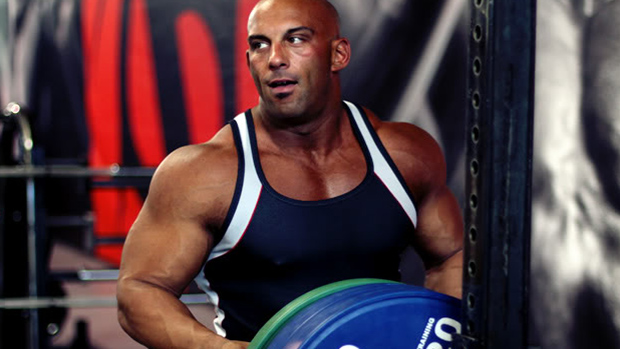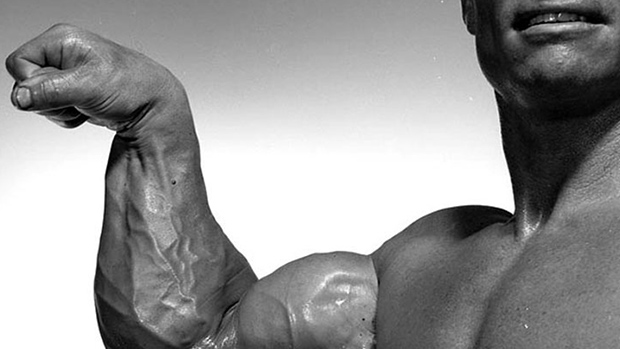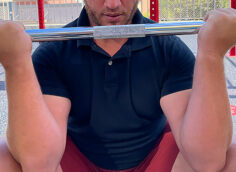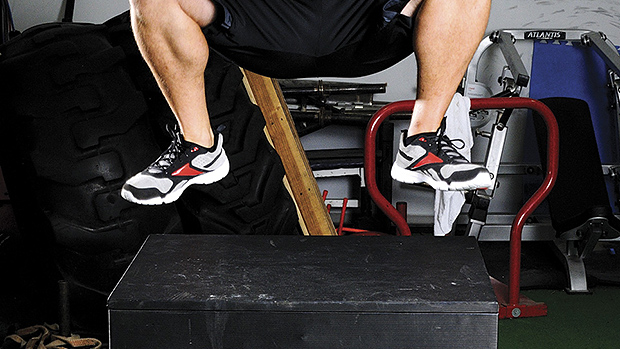The Most Powerful Muscle Building Program Ever?
When you observe the strength training community, you quickly notice how each coach has his own "pet program." For example, Coach Staley has EDT, Coach Poliquin has GVT and GBC, Chad Waterbury has several different programs, Westside guys have, well, Westside training, and the list goes on and on.
My problem is that I love the iron game so much that I'm never able to design what I'd call my "ultimate program." Sure, when I first talked about Optimized Volume Training it made a lot of noise, and many people fell in love with the program and the results it brought on. But I have a deep-rooted, visceral need to experiment and find new ways to spark muscle growth. As such, I always hated to limit myself to the confines of one single training methodology.
I personally need to be allowed some freedom when designing or using a program, and I'm sure that a lot of you are the same way. That having been said, it's also important to have a certain framework to work from. So I recently designed a training system specifically for bodybuilding purposes; one that has proven to be super effective for all those who've used it, and which stiall allows for a lot of variation.
This system is called HSS-100. Quite frankly, I never used anything as powerful when it comes to building muscle mass.
While it's a cool name for a program, it must mean something, right? It sure does:
- H = Heavy lift
- S = Superset (or triple set)
- S = Special technique or special exercise
- 100 = 100 rep set
Heavy lifting can stimulate muscle growth even though you're "technically" outside of the proper hypertrophy zones. It does so via three mechanisms:
1. Direct Action
Heavy lifting places an important growth stimulus on the fast twitch fibers. While the total volume might not be high enough to stimulate maximum muscle growth, it can certainly increase FT fiber size.
2. Indirect Action
Gaining strength will allow you to use more weight during a subsequent accumulation phase and this will translate into much improved gains.
3. Potentiating Action
Heavy lifting improves the CNS's capacity to recruit the high threshold fast twitch muscles fibers. These have the highest growth potential but are very difficult to stimulate. Increasing neural efficiency is a very effective way to develop the capacity to stimulate them and thus drastically enhance growth potential.
Plus, heavy lifting increases myogenic tone (tonus) which makes your muscles appear and feel "harder."
For this first exercise in your workout, you should pick a compound movement, preferably with free weights. For example:
- Quads: Front or back squat
- Hamstrings: Romanian deadlift or good morning
- Back: Bentover barbell rowing or chest-supported dumbbell rowing
- Pectorals: Incline, flat, or decline press (barbell or dumbbells)
- Deltoids: Push press, military press, dumbbell shoulder press
- Biceps: Standing barbell curl (barbell or EZ-bar)
- Triceps: Close-grip press (incline, flat or decline) or JM press
- Traps: Power shrugs (barbell or dumbbells)
You should train this first exercise mostly in the 4-6, 6-8, and 8-10 rep ranges, although it's possible to go down to 2-4 reps from time to time.
Between 3 to 5 sets should be performed (3 sets if working in the 8-10 range; 4 sets if working in the 6-8 range; and 5 sets if working in the 4-6 range).
A superset (basically alternating between two different exercises) can stimulate hypertrophy via several pathways. First of all, it drastically increases training density, which has been shown to favor the onset of an anabolic hormonal milieu mostly via an increase in growth hormone release. While I'll be the first to admit that transient hormonal changes won't turn you into the incredible hulk, when you want to attain that perfect physique every little bit helps.
A superset can also allow you to thoroughly stimulate a certain muscle group. This is accomplished by coupling a compound exercise with an isolation exercise. While it's no secret that big multi-joint, complex exercises are the best growth stimulator, they do have their shortcomings, the most important being that your body will always strive to complete the exercise with the less energy expenditure/effort as possible. This means that it won't necessarily put the most training stress on the desired muscle group, but rather on the one best suited to do the job.
For example, you might perform the bench press to build up your pecs, but if your front delts and/or triceps are overpowering, chances are that your chest will be left sub-optimally stimulated from your bench pressing work. By adding an isolation exercise for the pectorals either after (post-fatigue), before (pre-fatigue), or before and after (pre and post-fatigue) you'll be able to fully fatigue the chest.
As we just saw, there are three main types of supersets:
1. Pre-fatigue (isolation first, compound second)
dvantageous if you have problems recruiting a muscle group during a compound movement. Pre-fatiguing the muscle group will make it fail first during the compound lift.
Pre-fatiguing the muscle will also increase the mind-muscle connection as you'll "feel it" more because of the pre-existing fatigue/burn. So if you have problems "feeling" or recruiting a certain muscle group, pre-fatigue might be the solution. The downside is that you'll have to use less weight for the compound movement because of the pre-fatigued state of the muscle.
2. Post-fatigue (compound first, isolation second)
The main advantage of this method is that it allows you to keep on using big weights in the compound lifts because you're finishing the muscle with the isolation exercise instead of fatiguing it first. In most cases, this will lead to better growth stimulation.
However, if you have problems recruiting or feeling a certain muscle group during the compound lift, the post-fatigue method might not be as effective as the pre-fatigue method.
3. Pre and post-fatigue (isolation, compound, isolation)
This method combines the preceding two methods into one giant set of three exercises. It's very effective as it'll ensure that you fully annihilate the targeted muscle group, plus it'll improve the mind-muscle connection by pre-fatiguing it.
The downside is that this method is tremendously stressful on the body and nervous system. More than one such set is probably overkill for most natural trainees. However, if you decide to use this method and perform only one such giant set, it can prove to be quite effective.
The third exercise is used to really isolate the desired muscle group or portion of a muscle group. This is accomplished either by selecting a special exercise or a training technique favoring the development of the muscle group (e.g. iso-dynamic contractions are great to build the back, biceps, and hamstrings).
Here are some exercise suggestions:
Chest





Start at a high incline, perform reps to failure, drop down to a low incline, perform reps to failure, drop down to a flat press, and once again rep out to failure. Keep the same weight for all angles and don't rest between positions.




Simply execute the concentric (lifting) portion of the movement as a dumbbell press then the eccentric (lowering) portion as a dumbbell flye.
Back








Quads





Hamstrings




Biceps




The Jettison curl is a form of drop set. You begin with a dual source of resistance: a barbell plus a resistance band. You perform reps to failure with both implements. As you reach failure, you drop the resistance band and continue to rep out with only the bar. When you once again reach failure, you drop the bar, grab the band, and finish off with more reps to failure.


As you can see by the pics, you lift the weight with two arms and lower it using only one.
Triceps



Traps




Deltoids

The final exercise of the workout is a "flushing" set of 100 repetitions. Ideally you'd complete the 100 reps without any rest, but at first, while you build up your work capacity, it's okay to take a few 3-5 second pauses during the set.
The purpose of this set isn't to stimulate hypertrophy directly, but rather to enhance recovery from the previous workload. The very high rep/low intensity set will increase muscle flushing which will help bring blood and nutrients to the muscle group as well as the tendons.
It'll also help get rid of the metabolic wastes accumulated during the workout. Plus, systematic use of very high rep sets can increase muscle capillary density (more blood vessels going to the muscles) which will further enhance recovery capacity as well as work capacity.
There will still be a minimal hypertrophy effect from such sets, mostly in the slow-twitch muscle fibers. While athletes don't want that, bodybuilders who are only interested in size will accept any added hypertrophy they can get!
How do you put all this together? I'll show you! A workout will look like this:
Accumulation Phase (4 weeks)
- Heavy: 4-5 sets in the 6-8 rep range (with occasional foray into the 4-6 range)
- Superset (pre-fatigue) isolation movement: 3 sets of 10 to 12 reps
- Superset (pre-fatigue) compound movement: 3 sets of 8 to 10 reps
- Special exercise: 3-4 sets of 10-12 reps
- 100-reps exercise: 1 set of 100 reps
Intensification Phase (4 weeks)
- Heavy: 4-5 sets in the 4-6 rep range (with occasional foray into the 1-3 range)
- Superset (post-fatigue) compound movement: 3 sets of 6 to 8 reps
- Superset (post-fatigue) isolation movement: 3 sets of 8 to 10 reps
- Special exercise: 3-4 sets of 8-10 reps
- 100-reps exercise: 1 set of 100 reps
High Volume Phase (4 weeks)
- Heavy: 4-5 sets in the 8-10 rep range (with occasional foray into the 6-8 range)
- Superset (pre and post-fatigue) isolation movement: 1-2 sets of 10 to 12 reps
- Superset (pre and post fatigue) compound movement: 1-2 sets of 8 to 10 reps
- Superset (pre and post-fatigue) second isolation movement: 1-2 sets of 12 to 15 reps
- Special exercise: 3 sets of 12-15 reps
- 100-reps exercise: 1 set of 100 reps
Max Strength Phase (4 weeks)
- Heavy: 5-6 sets in the 1-3 rep range
- Superset (post-fatigue) compound movement: 3 sets of 4 to 6 reps
- Superset (post-fatigue) isolation movement: 3 sets of 6 to 8 reps
- Special exercise: 3-4 sets of 6-8 reps
- 100-reps exercise: 1 set of 100 reps
Training Split
With HSS-100, I suggest training each muscle group once every 5-7 days to allow for maximum recovery. The following split is adequate:
- Monday: Quads
- Tuesday: Back/Traps
- Wednesday: OFF
- Thursday: Hamstrings
- Friday: Chest/Shoulders
- Saturday: OFF
- Sunday: Biceps/Triceps
The HSS-100 system is probably the most powerful muscle-building program I've ever designed or tried. Understand that this program is designed to put a lot of beef on your frame and necessitates a large caloric intake with at least 1.25 grams of protein per pound of bodyweight.
Proper post-workout nutrition is a must and so is during-workout nutrition. The latter will allow you to reap the most benefits of the 100-rep set: you'll have more nutrients floating in your bloodstream to carry in your muscles during the 100-rep set.
The beauty of this program is that it can be adapted to your liking and needs. It allows for some variety while keeping its powerful effect. Most of all, it makes training fun again!





